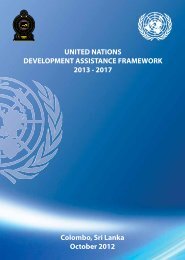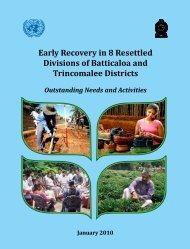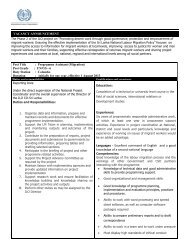Sri Lanka Human Development Report 2012.pdf
Sri Lanka Human Development Report 2012.pdf
Sri Lanka Human Development Report 2012.pdf
Create successful ePaper yourself
Turn your PDF publications into a flip-book with our unique Google optimized e-Paper software.
CHAPTER<br />
7<br />
Building<br />
on Peace, Progress and Security<br />
After nearly three decades of civil conflict, <strong>Sri</strong> <strong>Lanka</strong> is now<br />
on the road to long term peace and stability pursuing human<br />
development. But the costs of conflict have been high.<br />
It consumed thousands of lives, stirred distrust and<br />
hostility among ethnic groups and cost millions of dollars.<br />
Instead of being used for human progress, resources were<br />
diverted into military hardware and activities. Families<br />
were torn apart as people were displaced; education and<br />
livelihoods were interrupted. A considerable share of<br />
infrastructure in the Northern and Eastern provinces was<br />
damaged or demolished. Hundreds of square kilometres<br />
of land were mined.<br />
Rebuilding after massive destruction is one problem <strong>Sri</strong><br />
<strong>Lanka</strong> faces today, but not the only one. As demonstrated<br />
in this report, the country has achieved relatively high<br />
human development for a developing country, based on<br />
basic human development measures. But in some deprived<br />
areas, and in terms of more advanced measures of human<br />
development, disparities persist across the country.<br />
Those in the Northern and Eastern provinces are due<br />
essentially to prolonged conflict, while slow progress on<br />
the plantations stems from historical deprivations. But<br />
disparities also exist in rural areas and across provinces.<br />
Unless the structures and conditions that generate and<br />
perpetuate differences in access to services at basic and<br />
advanced levels are changed, and/or innovative solutions<br />
are found to reach all communities, achievements in<br />
human development may falter. Further, opportunities for<br />
productive and decent jobs need to expand, as otherwise<br />
social tensions may resurface.<br />
Why do some multi-ethnic countries, such as <strong>Sri</strong> <strong>Lanka</strong><br />
and Fiji in Asia-Pacific and Guyana in the Caribbean,<br />
erupt into violent conflict, while others remain peaceful<br />
for decades Many theories suggest triggering factors<br />
rooted in material circumstances or human nature.<br />
Under the theory of relative deprivation, violent political<br />
mobilizations are more likely to occur where discontent<br />
is induced by grievances. 326 When social, economic and<br />
political disparities overlap with the way population<br />
groups identify themselves, identities can be a powerful<br />
source of political mobilization. 327<br />
An alternative view theorizes that regardless of motive,<br />
when violent conflicts are militarily and financially feasible,<br />
they will occur. 328 The feasibility theory hypothesizes that<br />
three key economic characteristics drive susceptibility to<br />
violent conflict: the level, growth and structure of income.<br />
Countries with higher levels of income, higher growth rates<br />
of income, and those that are less dependent on primary<br />
resources for income are less likely to experience conflicts.<br />
The central implication, then, is that relative prosperity,<br />
widely distributed, is a key factor underlying peace. Grave<br />
and rising inequality, by contrast, could subvert it.<br />
The theory of relative deprivation is especially relevant to<br />
multi-ethnic societies, such as <strong>Sri</strong> <strong>Lanka</strong>’s, where disparities<br />
are prevalent. It underscores the need for inclusiveness,<br />
rather than marginalization, and for sharing the fruits of<br />
peace, progress and security more equitably. With this<br />
in mind, this report has identified 5 areas for action by<br />
relevant national entities and the private sector. Several<br />
actions are interrelated, since human progress often builds<br />
on multi-dimensional, holistic approaches. These must<br />
be supported by the requisite political will, resources,<br />
and governance structures and mechanisms. With<br />
peace coming forth after such a long and bitter struggle,<br />
<strong>Sri</strong> <strong>Lanka</strong> is well aware of the importance of getting to the<br />
root causes of problems, rather than treating symptoms.<br />
Establishing Priorities<br />
For a middle-income country, <strong>Sri</strong> <strong>Lanka</strong> has done well,<br />
with the highest <strong>Human</strong> <strong>Development</strong> Index rank in<br />
South Asia. It has strategically exploited development<br />
opportunities and husbanded its resources well, despite<br />
formidable obstacles. These opportunities are now almost<br />
fully harnessed, and their returns are too small to justify<br />
large amounts of additional investment. The country is<br />
poised at the edge of a new stage of development, where<br />
bold, strategic and innovative thinking is required.<br />
sri lanka <strong>Human</strong> <strong>Development</strong> report 2012 119






